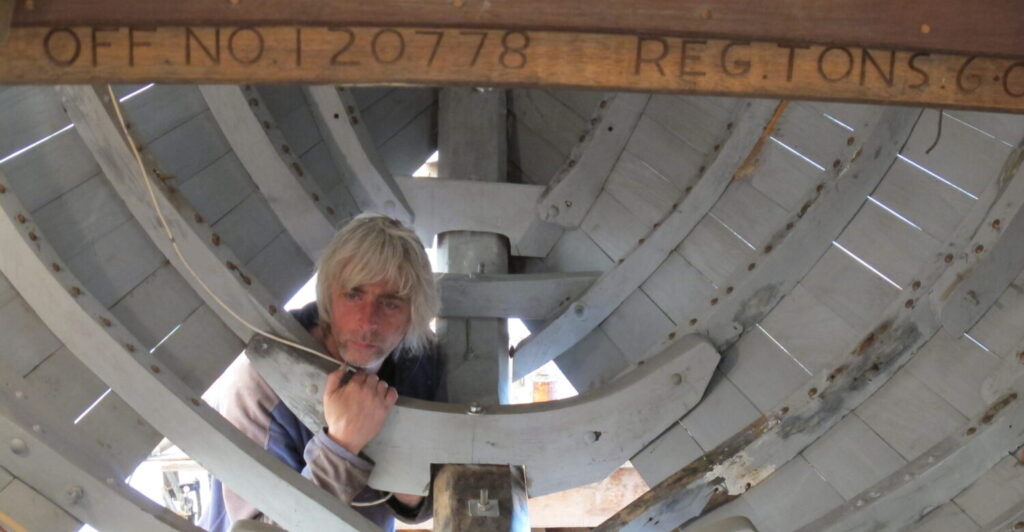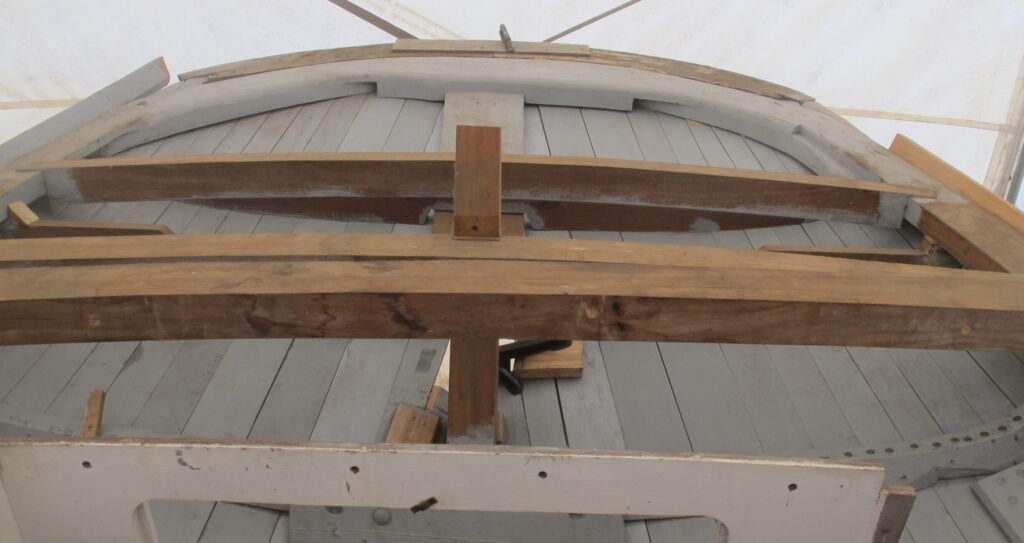 Restoration
Restoration
Finishing the hull, 2012
Looking at the depleted woodpile in May 2012, the remaining planks were checked against the shift of butts plan to provide a final list of what we’ll need to complete the hull.
With all the frames and floors bolted up and painted, despite it being the first week in June, the weather looks set continue cold, wet and very windy. As we became used to the incessant noise of clanking halyards and flapping canvas, snuggling up with extra thick socks, blankets and fleeces to stay warm at night, Steve started to do small repairs, as he couldn’t do anything that meant leaving the shelter of the tent. Is this really ‘flaming June’? Carefully crafted graving pieces and splines were made up, glued in place and sanded down before we finally retreated home as the weather didn’t improve. A call from Andy at St Osyth’s, where we’d been to choose more wood, asked us to collect the planks. Steve drove to St Osyths from Derbyshire, taking advantage of Martin’s kind offer of a loaned van to transport the larch to Woodbridge, returned the van to Martin and drove back to Derbyshire completing the 500-mile journey in the one rare day it wasn’t forecast to rain! By all accounts, the trip was quite an epic, with the long boards tied to the roof, but the larch is now safely ‘sticked up’ and ready for use.







Briefly returning to Woodbridge in July, Paul and Steve drop two of the keelbolts, and check them out carefully. They came out clean, but will need replacing. This prompted a call to Adrian, the surveyor, and he popped round to take a look while there’s still some missing planks to peer through into the hull. With all the frames in place, in September we engage Paul to work with Steve to complete the hull! The boards from Andy at St Osyths vary quite dramatically in thickness, apparently he had problems with his saw. This necessitates careful planning in order to make best use of the remaining timber. Beverley’s set the task of working out how many more nails, screws and roves we’ll need, and converting the number of nails into kilograms for the order from Anglia Stainless! How many times did she revise her calculations before calling?
Steve and Paul get started in earnest, just two full lengths to do on port and starboard. Ben from Anglia Stainless arrives with the final order, and getting the bill reminds us just how important it is to keep the scraps of copper and bronze. The screws are coming up at £1 each. The nails aren’t cheap either, especially when you think about the bit you nip off every time you put on a rove! The final planks have to ‘herringbone’ into the counterstern, which calls for some careful deliberations, leaving space for the rudder stock. Paul and Steve ask, ‘Where’s the old photos from when we first took the paint off?’ At last, the plan was drawn up. It’s almost becoming a contest between Paul and Steve, in the September sunshine to complete the planking on the port and starboard sides, working towards the ‘shutter’ planks at stem and stern. There’s one or two periods of frustration, as a plank splits at the last moment, or just won’t be persuaded to take the curve. We find an extra board, sourced from Pete’s remaining stock for ‘Transcur’ ten years ago, has woodworm! So out that goes, quick as a flash, and it’s back to getting the last couple of planks out of existing stock!








Beverley is sent out to town to buy the whisky as the final plank is fitted, 20 September, 2012. Paul Masters joins us on Sunday to finish nailing up, as Beverley’s hurt her back and can’t hold the ‘dolly’. All the planks are securely nailed with roves and butt blocks. The inside is all cleaned out and we declare the hull complete! Although all the planks and frames are done, there’s still lots to do before the hull’s finished. Thousands of bungs, carefully made over the winter, have been counted out into coffee tins. These need glueing carefully over the fastenings, with the grain going the right way. Beverley’s banned from this task, as she just can’t get the grain going right! There’s a bit of repair work here and there, as well as checking over knots and glueing bungs to replace them if necessary. The excess putty needs cleaning from the seams at all the butt blocks. Beverley’s role in all of this is to keep everything shipshape, get the provisions in, maintain the archive, keep the business going, do all the cooking and a few of the less skilled work on the boat itself.



